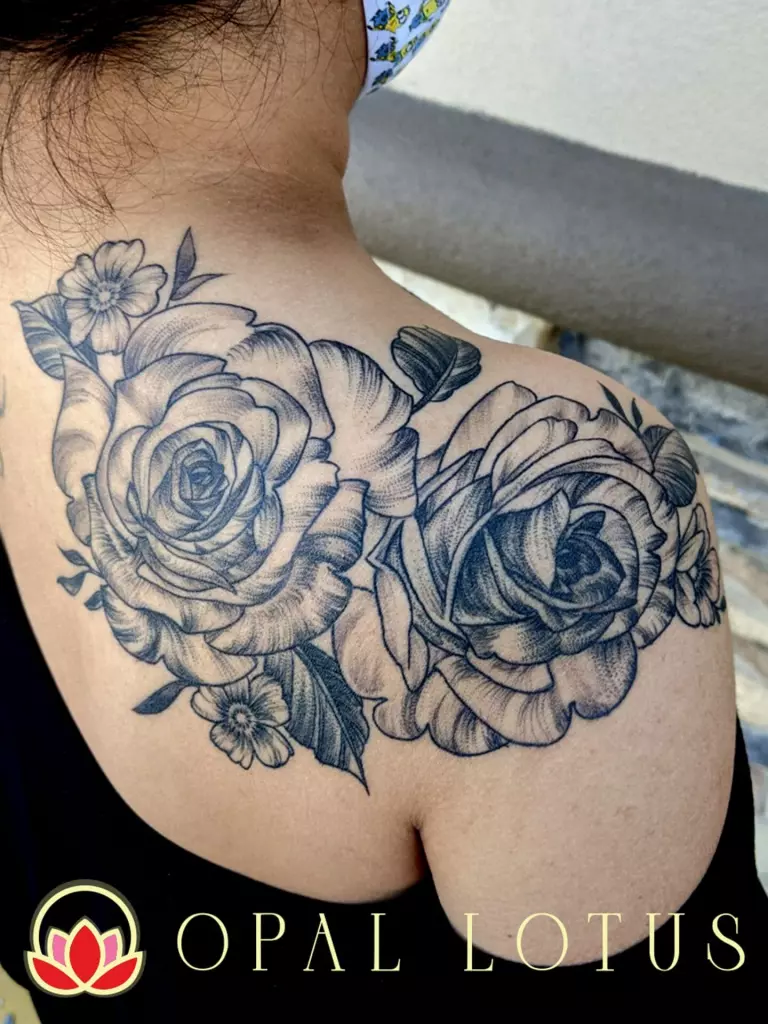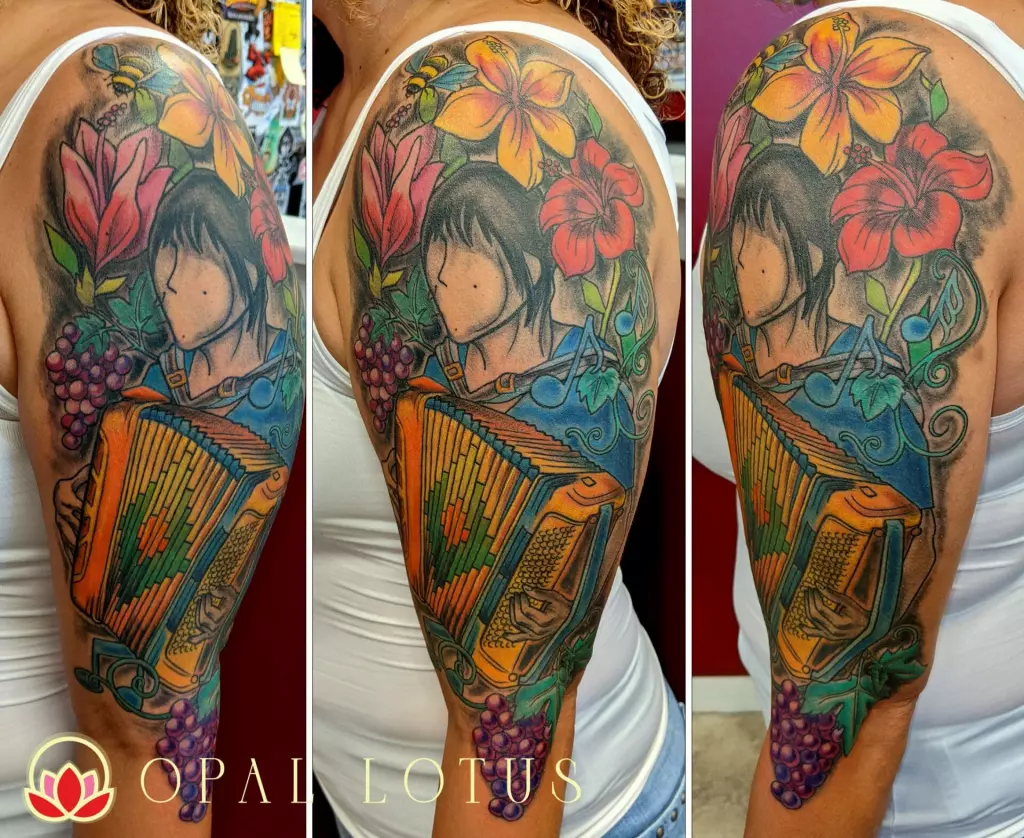Day by Day Care Instructions
Your tattoo artist will give you detailed instructions on how to take care of your tattoo. For caring after your tattoo, they are the ones to trust.
These instructions will ensure that your tattoo looks radiant and clean.
Day 1
After you leave the tattoo shop, take a few hours to remove the bandage the artist has applied. Your new tattoo should breathe.
Cling film should be applied 3-4 hours after the tattoo is completed. It is important to remove the cling film before going to bed.
For the first 24 hours, leave a special tattoo film your artist used on you.
Tattoo wrap
Make sure that the wrap is securely in place to prevent it from being exposed to your skin while you sleep.
Professional tattoo cleaner
Wash your bandages gently with only water, a neutral soap or a tattoo cleanser when changing them.
Some artists may recommend that you keep the initial bandage on your first night in order to prevent rubbing and leaking.
Make sure you get tattoo film that are breathable if you want to cover your tattoos.
Protective tattoo films
TIP 1: Make sure you use clean sheets and towels while sleeping
You should use clean sheets you don’t care about in case you make a mess or if you stain the sheets. Your health and the sheets’ good!
Check out this article: How to Sleep with a New Tattoo
TIP 2: Don’t dry your tattoo on a towel.
It is also a good practice to not dry your tattoo using a shared towel. It is best to use kitchen paper to dry your tattoo. Use only one regular towel if you prefer a tattoo.
The area to be tattooed should be treated as an open wound for the first 2 to 3 days.
Day 2
Use a plastic bandage if you aren’t using it. Now you can begin your washing and moisturizing routine.
Protective tattoo film should be removed. Clean the area and then apply a thin layer of moisturizer.
WASHING AND MOISTURIZING ROUTINE – Wash the skin at least twice a day, then moisturize the area.
TIP: Use your hands to wash the tattoo. Use gentle pressure, but not too hard.
Day 3
Use water and soap to clean the tattoo, depending on how often you use it.
Apply regenerative cream after your tattoo is dry. Some people heal more quickly, and their skin dries quicker;here you can apply the balm less often.
We recommend balm that has regenerative, protective and anti-bacterial properties. It also soothes itchy skin.
TIP: Avoid using too much ointment.
It should only be a thin, consistent layer. It should be rubbed in well so that it isn’t clumped up.
You can gently remove any excess using kitchen paper.
DAYS 4-15
Do the same as before.
Apply balm to the tattooed area after you have washed it.
NOTE: It is possible for larger tattoos to take longer to heal. Therefore it is recommended to increase your washing schedule by one week.
Keep this in mind:
You should wash your hands before you touch your tattoo. It is best to treat your tattoo as an open wound.
For tattoo washing, use cool to lukewarm tap water. You could damage the tattooed areas by using hot water.
Only use your hands to clean your tattoo. You should not use towels, loofahs, or washcloths on your tattoo. They can exfoliate your skin too much. Avoid scrubbers.
Use kitchen/towel papers to dry your tattoos.
You can only use one balm per tattoo so that there is no cross infection.
Important: Your tattoo cannot be saved from germs and bacteria until it has been scabbed, peeled and cured. Even then, it is vital that you continue with aftercare.
General Aftercare INstructions
Make the most out of your tattoo artist’s hard work now – don’t wait, start following these guidelines right away to ensure your tattoo looks its freshest and heals quickly. Take the necessary precautions now and be amazed at how well your beautiful artwork will look. Don’t hesitate, act today and reap the rewards when it heals.

Things To Know: Tattoo Aftercare
Your tattoo will be swollen
You can expect to see your new tattoo swollen, reddened, bloody, and sometimes bruised when you take off the bandage applied by your tattoo artist.
These are normal, temporary reactions to trauma. So don’t worry.
You can expect some swelling and blood from tattoo machines that pierce your skin up to 3,000 per minute.
It will get messy
The first few days after your tattoo is applied, it will ooze fluids, such as blood, clear plasma, and ink. These are signs that your body has recognized the trauma and is sending cells back to fix it.
You might not be happy with the results for the first few weeks, but you will have to learn to trust the process.
Expect itching and scabbing
Expect to experience scabbing and itching. A protective layer that covers your skin’s wounds, also known as the tattoo, is called a scrub. It prevents bacteria, germs, and other harmful substances.
If you notice scabs appearing, that means your tattoo is healing properly. Your body is doing its best to repair itself.
Although it can be irritating, this protective layer should not last more than a few days.
You may be slightly under the weather
You may feel unwell for several days after getting a bigger tattoo. Sometimes you might feel like your body has caught a cold.
Stress can cause your immune system to be compromised and increase your chance of becoming sick. However, your body should feel as good as new in just a few days.
Keep in mind that the easier it is to get tattooed, the more you do it.
Stages for Tattoo Healing
Each person’s healing journey is unique, depending on their age and tattoo placement.
Your ribcage, which isn’t covered in fat or muscle, may take longer to heal than a bicep. In either case, healing is similar for everyone.
This is a diagram of a typical tattoo-healing process:
Days 1-6
The new tattoo will be reddish and swollen. It will also still contain blood, plasma and lymphatic fluid. This is the worst part of the healing process. But it should fade after a few more days. Over your tattoo, scabs will form.
Days 7-14
The scabs may get itchy and your skin might flake. This is an essential part of healing. The scabs will eventually fall off and reveal healthier skin beneath.
This will cause your tattoo to look dull and dry. Keep it moisturized.
Days 15-30
Your tattoo should not experience further swelling, bleeding, ink leaching, or any other symptoms.
Do not be alarmed if your tattoo does not look as crisp and clear as you would like. Your deeper skin layers still need to heal. Aftercare is vital even after your tattoo is done.
These Tips Will Help Your Tattoo Heal
Your new tattoo will produce plasma, which can cause wounds to scab. You can gently wipe away the wet plasma by gently patting it off to prevent it forming large scabs which could crack.
To wash your tattoo, use cool to lukewarm water. Too hot water can open your pores and cause ink leakage.
If your skin is sensitive and it hurts to dry after washing, you might use a hair dryer with a cool setting to dry the tattoo.
For the first few nights, don’t worry about your bed sheets. Your new tattoo may leak ink and cause stains on your sheets.
Before you apply the ointment to your tattoo, ensure that it is completely dry. You could end up with scabs that are swollen or gooey if the ointment is not completely dry.
A cold compress can be applied to itchy tattoos. You can apply a cold compress to relieve the itching immediately without needing to scratch. Only do this after the skin’s upper layer has fully healed.
Drink lots of water. Your skin makes a tattoo look better. The more you hydrate, your tattoo will be more vivid.
Don’t listen to family members or friends. Many people will claim they have the answers to speed up your tattoo’s healing, but you should always follow your artist’s directions.
WHAT NOT TO DO AFTER GETTING A TATTOO
There are many reasons tattoo healing could go wrong. This could lead to an infection, or even a ruined design.
These are the things you need to avoid if you want to keep your tattoos beautiful and healthy.
Do not do the following:
- Scratch, peel, pick, rub your tattoo
- Let your tattooed body dry
- Go swimming or in a hot tub
- Keep your tattoo out of the sun for the first two to three weeks
- Wear tight clothing with your new tattoo, such as bra straps or waistbands.
- Start exercising within the first few Days
- Get near or apply your new tattoo
Wait until you see a doctor. Consult a doctor immediately if you feel or see any infected areas on your tattoo.
SIGNS OF INFECTION
It’s hard to distinguish between what is normal and what you should seek medical attention.
It is rare for tattoo-related infections to occur these days. Between 0.5 and 6% of tattooed adults experience one. But they exist.
These symptoms should be reported to your doctor immediately.
Here are some things that are not normal:
- Intense pain
- Worsening swelling
- Pus draining
- Firm bumps (granulomas)
- Excessive bleeding
- Photosensitivity is a painful reaction to sunlight.
- Fever. Chills. Sweats.
HOW TO AVOID INFECTION
Picking the right tattoo studio is key to avoiding infection from viruses or bacteria.
Only trust licensed, hygienic, skilled professionals. You should never attempt to do it yourself, use stick-and-poke tattoos or use improper aftercare products. These could lead to serious infections.
It is possible to be a bit more expensive than you need, but it can still make a difference.
Pre-existing conditions like Hepatitis C, HIV, Hepatitis B, Hepatitis C, Hepatitis D, or Eczema should be disclosed to your tattoo artist. These conditions can increase your chance of complications and infection.
The tattoo artist won’t turn you down, but they’ll have to take extra safety precautions while tattooing you. Honesty is the best policy in assessing the risks involved in getting a tattoo.
Talk to your doctor if you are taking Accutane or other blood thinners.
FINAL THOUGHTS
Although tattoo aftercare can seem overwhelming at first glance, if one is able to endure the pain of a tattoo, it can be a way to conquer any obstacle.
Follow the instructions given by your tattoo artist. Don’t forget to wash and moisturize.
For a beautiful, healthy tattoo, it is vital to keep your aftercare commitments.
You’ll soon be able to show off your new ink with this step-by -step guide.

walk ins welcome
Get inked today!
Don’t wait – chip away at that lingering desire for a tattoo and come to Opal Lotus today! Our certified artists will bring any design to life, so seize the moment and book an appointment now! Get ready to present yourself with the confident look you’ve always dreamed of.

